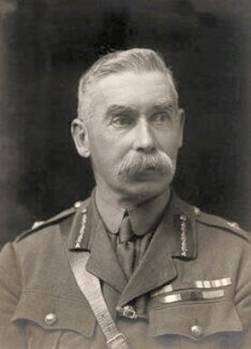
Major
FRED HARRISON
Royal Engineers
By
Lieutenant
Colonel (Retired) Edward De Santis, MSCE, PE, MInstRE
U.S. Army Corps of Engineers
(July 2020)
1. INTRODUCTION
Researching
Captain Harrison’s life and military service was a challenge.
It started with the acquisition of his 1914 Star medal, which he received
for service in the Great War of 1914-1918. The
medal was purchased in 1984 and it was not accompanied by the British War Medal
and Victory medal, two medals to which he would have been entitled for his
service. Very little was done to
research his life and service until just recently.
What made research efforts difficult was the naming on the medal which
consisted only of:
HON:LIEUT.F.HARRISON
R.E.
The
lack of a middle initial certainly made things difficult and Harrison is not an
uncommon name as I was to find out. What
lead to the breakthrough in the research project was the HON in his rank
standing for Honorary. By chance I
found an Honorary Lieutenant by the name of F. Harrison in the February 1915
edition of the Army List under STAFF FOR ROYAL ENGINEER SERVICES.
This find enabled me to produce the narrative that follows.
Definitive information about his early life and family could not be found during this research work mostly because there are very many men named Fred Harrison. Using Ancestry.com and searching for men by this name in the United Kingdom did not produce “reliable” results. Through a research service known as Forces War Records, a hospital admissions record for a Captain F. Harrison, Royal Engineers was located. The record was dated 1917 and it indicated that he was 29 years of age, thus making his year of birth 1888 if this was truly his age in 1917. More information regarding this hospital record will be provided in a subsequent section of this narrative. The information contained in the record was important because it validated other information that was discovered about Harrison.
The 1911 Census of England and Wales shows a young man by the name of Fred Harrison, a 21-year old “Engineer,” living with his parents at 8 York Place on York Street in Wakefield, West Yorkshire. Major Fred Harrison would have been 23 years of age in 1911, assuming that his birth year of 1888 is correct, so there is a difference of 2 years in their ages.[1] The only significant link between the men is the profession of Engineer, although the address of Fred Harrison in the census is significant since a man by that name married a woman by the name of Anne Battersby in Halewood, Liverpool, a town only 78 miles to the west of Wakefield. As will be shown in Section 7 of this narrative, there is Fred Harrison with a wife by the name of Anne found aboard a ship bound for New York in 1939. The author realizes that there is much conjecture associated with these links and that they may or may not be links to the main subject of this research; however, they are presented here for the reader to consider and to decide if the two Harrisons are one in the same man.
3. COMMISSIONING AND
TRAINING
Works
Directorate of the Royal Engineers
Harrison
was not commissioned in the ordinary manner, nor did he receive any military
training before entering the Army. To
understand how he came to serve in the Great War one must know something about
the unit in which he served; that is, the Works Directorate of the Corps of
Royal Engineers.
The
Headquarters of the Works Directorate mobilized on the 5th of August
1914 at the Kensington Palace Hotel in London.
It consisted of Brigadier General A.M. Stuart, CB,
[2]
the Director of Works (D.W.), with two officers and nine other ranks.
Stuart
and his headquarters party left London for Southampton on the 9th of
August 1914. Prior to leaving they
did a considerable amount of work in collecting information as to the types of
buildings likely to be required on the Line of Communication in France.
The D.W. had an interview with the Quartermaster General during this
period, who instructed him to act, on mobilization, directly under the orders of
the Inspector General of Communications (I.G.C.).[3]

Figure 1.
Brigadier General Andrew Mitchell Stuart, CB, R.E.
(Photograph courtesy of the National Portrait Gallery)
Stuart’s
party arrived at Havre on the 10th of August 1914.
He worked with the French to make preliminary arrangements for the
reception of troops of the British Expeditionary Force.
These arrangements consisted of the selection of camping grounds,
hospitals, field bakeries, remount depots, veterinary hospitals, post offices,
offices buildings and billets, as well as provisions for water supply.
The
only units of the Royal Engineers placed at the disposal of the D.W. at this
time were the 20th Fortress Company and the 29th Works
Company.[4]
A number of R.E. officers were attached to the Works Directorate to
superintend the work to be carried out. At
one time shortly after Stuart set up his headquarters in France he had as many
as 15 senior officers and 20 junior officers of the Royal Engineers at his
disposal. However, owing to the
heavy casualties at the front, most of these officers, and especially the junior
ones, were drawn upon to fill vacancies in field companies and other R.E. units
in Corps and Division areas.[5]
Temporary Inspectors of Works
Since few R.E. units were available to do the work required by the Works
Directorate it was necessary to contract the work out to British and French
firms. The lack of Regular Army
officers of the Royal Engineers to supervise the work of these contractors also
was a problem. Therefore, for
supervision of the contract work professional men, civil and mechanical
engineers, architects and surveyors all with experience in civil life were
selected by the War Office and commissioned under the designation “Temporary
Inspectors of Works.”[6]
These men would receive direct commissions as Honorary Lieutenants and
would not receive any military training before going to France.
They would form what was to be known as the Staff for Royal Engineer
Services.[7]
Fred Harrison was one such professional man.
He was appointed an Honorary Lieutenant, Inspector of Works on the 15th
of November 1914. The details of his
professional qualifications are unknown, but he must have been an engineer or in
a profession associated with construction or other technical services in order
to be designated an Inspector of Works.[8]
4.
ASSIGNMENTS AND CAMPAIGN SERVICE
Director
of Works Staff Officers
The first Director of Works Staff Officer to disembark in France was Honorary Captain Samuel Roberts, Inspector of Works. He arrived on the 15th of October 1914. Roberts was 40 years old at the time that he arrived in France and unfortunately he died on the 6th of December 1914.[9]
The first batch of Honorary Lieutenants, Inspectors of Works, five in number, arrived in France on the 26th of November.[10] The date of Harrison’s arrival is open for some debate. His Medal Index Card (M.I.C.) indicates that he arrived in France on the 21st of October; however, the R.E. medal roll for his 1914 Star shows his date of disembarkation for eligibility to receive the medal as the 21st of November 1914. There are nine other Inspectors of Works listed on the same roll with a date of disembarkation of the 21st of November, so it is obvious that the handwritten date entry on Harrison’s M.I.C. is in error. No medal roll has been found to substantiate the entry in the book Work Under the Director of Works that indicates that the first five Honorary Lieutenants arrived on the 26th of November. The other officers who arrived in France on the same date as Harrison were:
· Honorary Lieutenant G.H. Crickmay.
· Honorary Lieutenant T.H. Hopkins.
· Honorary Lieutenant W.L. Loutet.
· Honorary Lieutenant T.E. Thain.
· Honorary Lieutenant G.E.L. Poulden.
· Honorary Lieutenant A.J. Smith.
· Honorary Lieutenant C.E. Townsend.
·
Honorary Lieutenant A.C. Wilmot.[11]
Another officer, Honorary Lieutenant and Quartermaster W. Reid, 29th Works Company, also disembarked on or about this date.
Works
Services
The services of these officers proved invaluable to the efforts of the Works Directorate in France. Additional officers followed at short intervals making a total of 20 and by the spring of 1915 there were 40 Inspectors of Works in France.
Some mention has already been made regarding the types of facilities for which these officers were responsible. Work Under the Director of Works provides a comprehensive list of these facilities and the technical responsibilities of the Directorate, to include the following:
· Accommodation for troops
· Aerodromes and Royal Air Force installations
· Protection Against Aircraft Attack
· Ammunition Depots
· Bakeries
· Ordnance, Supply and Motor Transport Depots and Workshops
· Electrical Supply
· Fat-Extracting Plants
· Forestry Facilities
· Hospitals and Medical Establishments
· Designs for Hutting
· Power Laundries
· Pig and Goat Farms
· Military Prisons
· Quarries
· Remount Depots
· Sanitation Facilities (Foul Water and Disinfecting Apparatus)
· Special Transportation Services
· Veterinary Establishments
· Water Supply
Types
of Troop Accommodations and Sheds
The area of accommodation for troops was an important responsibility and mainly involved the design and erection of structures known as “huts.” The Great War brought about much innovation in this area and a number of engineer officers designed portable buildings that were used during the war and long after the war. Captain R. G. Brocklehurst, R.E.S.[12] was responsible for the design of two such huts generically known as light portable buildings. Brocklehurst was the officer in charge of the Design Branch at the Director of Work’s Headquarters. His design was considered to be the standard pattern light hutting suitable for latrines, ablutions and small cook-houses. They were constructed of timber and corrugated metal sheets in the workshops of the District Engineers and sent out to bases throughout France and Belgium as needed. Brocklehurst also was responsible for the design of “Forest” huts to provide living quarters in forest camps. This hut, which was 26 feet by 13 feet, was turned out in large numbers by French contractors.[13]
“Liddell Huts,” or the Liddell Portable Hut, was designed and patented by a Works Officer, Major Guy Liddell, R.E. This hut consisted of self-contained panels of boarding or corrugated iron on a timber framework.[14]
“Nissen Bow Huts” were designed by Captain Peter Norman Nissen, DSO, R.E. (6 August 1871 – 2 March 1930). Nissen was a Canadian-American-British mining engineer and inventor. He held a number of patents for his inventions and developed the Nissen hut prefabricated shelter during the Great War. He was the Officer Commanding the 29th Advanced Park Company, R.E. when he completed the design. These huts were 27 feet by 15 feet, semi-circular in shape and covered with bent corrugated iron sheets. The floor of the hut consisted of 1-inch boards on 4-inch by 2-inch joists made up in panels measuring 4 feet by 6 feet 9 inches. The whole structure rested on a foundation composed of 7-inch by 4-inch sleeper joists. Many improvements were made by Captain Nissen in the hut from time to time, but the changes did not materially affect the original design.[15]
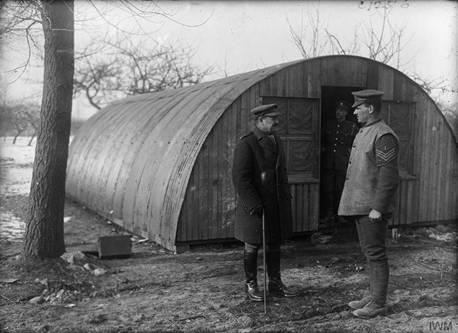
Figure 2. Nissen Talking to
Acting Company Sergeant Major Frederick T.E. Skinn, 29th (Advanced Park)
Company, R.E. in Front of a Nissen hut in 1917.
(Photograph courtesy of Wikipedia)
Another notable design was the “Rootham” Steel Aeroplane Shed by Captain H.W. Rootham, R.E.S. while he was employed in the Director of Works Headquarters office. This was a light steel shed with a 60-foot span intended principally for housing aircraft.
The
Service of Honorary Captain Fred Harrison
The rather lengthy list of Works facilities and services above makes it clear just how essential the Works Directorate was to the support of the Army in the field. The Inspectors of Works were spread far and wide supervising the construction and maintenance of these various facilities and inspecting their operations. Primary bases where they were posted include Amiens, Rouen, Boulogne, Havre, Etaples, Calais and Paris with many smaller bases located throughout France and Belgium. Without access to Harrison’s service papers it is not possible to know precisely where he served. Even with his papers only the major bases to which he was assigned might be known without ever knowing which smaller bases he might have worked at. It is thought that he was posted to the base at Le Havre. The reasoning behind this assumption will be explained subsequently. Details of the works undertaken at the base at Le Havre may be found in Annex C at the end of this narrative.
Apparently Harrison performed his assigned duties in an exemplary manner. He was promoted Honorary Captain (except for pay and allowances) on the 24th of January 1916.[16] In the London Gazette dated 4 January 1917 he was mentioned in the 13 November 1916 despatch of General Sir Douglas Haig for distinguished service and devotion to duty. This despatch was written at the conclusion of the major, but very costly, offensive on the Somme.
Artisan
Works Companies
The Works Directorate controlled many units on the Line of Communication in France and Belgium (see Annex A). Some of the major units employed were Artisan Works Companies. The personnel of Artisan Works Companies were unarmed. They were well over military age but fit for general service. They were all artisans and received no military training. The companies were formed slowly owing to the problems of recruiting. By the end of 1916 only 2 Officers and 80 Other Ranks had arrived in France to form the nucleus of the 51st and 52nd Artisan Works Companies. In the spring of 1917 it appears that Harrison may have joined one of these companies on a temporary basis.
The London Gazette of 13 May 1917 contained an entry indicating that Temporary Inspector of Works and Honorary Captain F. Harrison was transferred from the Staff for Royal Engineer Services to be Temporary Captain. This entry appears to indicate that he left the R.E. Services Staff and was posted to an R.E. unit in the field. On the 11th of September 1917 he was admitted to the 2nd General Hospital (officers) at Le Havre with colic.[17] His admission number was 1035 and his age on the admission form was noted to be 29 years.[18] The form also indicates that his had three years of service and that his number of months with the Field Force was 36. His unit is indicated on the admissions form as Artisan Works Company. There were two Artisans Works Company in France at the time working under the Directorate of Works; the 51st at Havre and the 52nd at Boulogne. He had probably been posted to one of these companies on temporary duty; hence, the 13 May 1917 London Gazette announcement of his transfer out of the R.E. Services Staff. He was discharged from the hospital and returned to duty on the 21st of September 1917[19] and probably returned to the Artisan Works Company in which he had been serving. Since he was in hospital at Le Havre and this is where the 51st Artisan Works Company was located in 1917, it is most likely that he returned to this unit.
Work
with Engineer Districts
On the 15th of August 1918 Harrison was appointed Deputy Assistant Director of Works (Class BB) and Temporary Major while he was so employed in this position.[20] Posting to this position indicates that he probably was serving in a 1st or 2nd Class Engineer District in the Works Directorate in France, again, probably at Le Havre. The Commanding Royal Engineer (C.R.E.) of these districts was a Lieutenant Colonel and as the Deputy Assistant Director Major Harrison would have been second-in-command. The staff of the 1st and 2nd Class Engineer Districts consisted of the following personnel:[21]
· Commanding Royal Engineer
· Staff Officer for Personnel and Correspondence
· Superintending Inspector of Works for Contracts and Finance
· Engineer Division Staff Officers (as required)
· Officer in Charge of Stores
· Mechanical and Electrical Officer
The units operating under 1st and 2nd Class Engineer Districts included the following:[22]
· A section of an Electrical and Mechanical Company, R.E.
· Artisan Works Companies (as required and available)
· Area Employment Artisan Companies (as required and available)
· Chinese Labour Companies (as required and available)
· Prisoner of War Companies (as required and available)
Harrison worked as a Deputy Assistant Director of Works until the 1st of January 1919 when he was appointed Assistant Director of Works (Class X) and Temporary Lieutenant Colonel, while so employed.[23] In this position he could have served as the C.R.E. of a 1st or 2nd Class Engineer District as described above or as the C.R.E. of a 3rd Class Engineer District. The 3rd Class Engineer District was composed of the following elements, similar to the 1st and 2nd Class Engineer Districts but on a smaller scale:
· Engineer Division Staff Officers (as required)
· Warrant Officer or NCO in Charge of Stores
· A section of an Electrical and Mechanical Company, R.E.
· Artisan Works Companies (as required and available)
· Area Employment Artisan Companies (as required and available)
· Chinese Labour Companies (as required and available)
· Prisoner of War Companies (as required and available)
Disposal
of Surplus Stores
On the 8th of March 1919 Harrison was given a new job. He was assigned to the Disposal of Surplus Stores with the rank of Temporary Captain (Temporary Lieutenant Colonel), retaining the higher temporary rank while so employed.[24] The war had been over for four months and there were all sorts of equipment and stores that were now considered to be surplus to the needs of the Army. Like all armies everywhere and at any time, the cost of returning equipment and supplies home was always compared to the value of the items in question. Obviously this was also true for the British Army in France and Flanders, true to the point where a special agency was formed to dispose of surplus stores.
Harrison worked on the disposal of surplus stores for almost a year and on the 11th of February 1920 he relinquished his rank of Temporary Lieutenant Colonel and reverted to the rank of Temporary Captain. Apparently he was demobilized sometime in 1920.
Harrison was awarded the 1914 Star on the 28th of May 1920.[25] Since he was not under fire during the period in 1914 when the Star was authorized, he was not entitled to the “Mons” bar.[26] He was awarded the British War Medal and Victory Medal on the 8th of October 1920.[27] The roll authorizing him these last two medals shows his rank as Major, so presumably he was promoted just prior to demobilization with an honorary rank.
______________________________________________________________________
The following sections are presented in tabular form to summarize Major
Harrison’s promotions, appointments, and qualifications and the medals that he
was awarded during his time in the Army. They
are provided to give the reader easy access to these aspects of his military
career.
__________________________________________________________________________
5.
PROMOTIONS AND APPOINTMENTS
Fred Harrison received the following promotions during his time in service:
Date of Promotion or Appointment |
|
|
15 November 1914 |
Appointed Temporary Lieutenant, Inspector of Works, Royal Engineer Services. |
|
24 January 1916 |
Promoted Temporary Captain, Inspector of Works, Royal Engineer Services. |
|
13 May 1917 |
Appointed Temporary
Captain, Royal Engineers. |
|
15 August 1918 |
Appointed Temporary
Major, Deputy Assistant Director of Works. |
|
1 January 1919 |
Appointed Temporary Lieutenant Colonel, Assistant Director of Works. |
|
8 March 1919 |
Appointed Temporary Lieutenant Colonel, Disposal of Surplus Stores. |
|
11 February 1920 |
Reverted to the rank of
Temporary Captain. |
1920
|
Promoted to the rank of Major. |
6. MEDALS, AWARDS AND
DECORATIONS
Major Harrison is believed to have received the following medals, awards and decorations during his time in service.[28]
|
Date
of Issue |
Medal |
|
28 May 1920 |
1914 Star
named in impressed upper case letters as follows |
|
8 October 1920 |
British War Medal |
|
8 October 1920 |
Victory Medal with Mention in Despatches Oak Leaf |
|
|
|
Figures
3 and 4. Mention in
Despatches of General Sir Douglas Haig. |
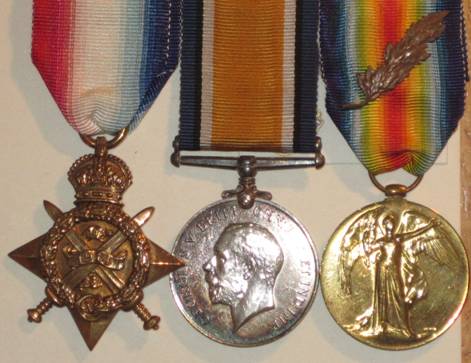
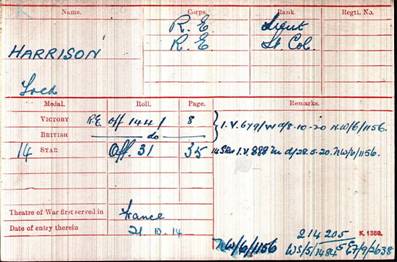
Figure 6. The Medal Index
Card of Fred Harrison (front side)
(Image courtesy of Ancestry.com)
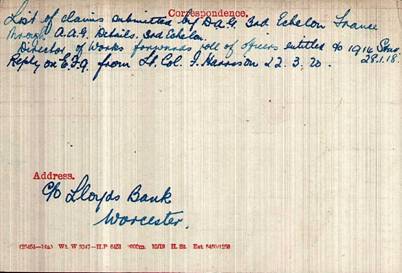
Figure 7. The Medal Index
Card of Fred Harrison (back side)
(Image courtesy of Ancestry.com)
The front side of the Medal Index Card shows the authorization of the three medals. It also lists two ranks; Lieutenant and Lieutenant Colonel. This is curious as he only held the rank of Temporary Lieutenant Colonel from the 1st of January 1919 until the 11th of February 1920. He is not shown as a Lieutenant Colonel on the medal rolls for the British War Medal and Victory Medal, but apparently the Director of Works forwarded the medal rolls to the Deputy Adjutant General, 3rd Echelon France, indicating that Harrison’s rank was Lieutenant Colonel. The Quarterly Army List ending 31 December 1919 (War Services of Officers of the Army) shows his rank as Temporary Captain; however, this list does not cover the period in 1920 when he was Temporary Lieutenant Colonel.
The Medal Index Card also is incorrect, as previously explained, where it indicates Harrison arriving in France on the 21st of October 1914 when actual date of disembarkation was the 21st of November 1914. The reverse side of the card indicates that Harrison could be reach through Lloyd’s Bank in Worcester. Unfortunately no more precise address is available for him after he left the Army.
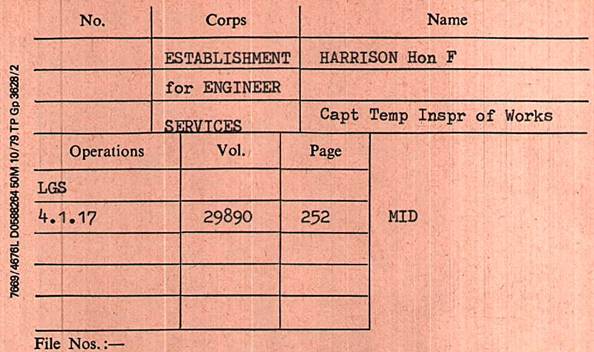
Figure 8. Medal Card Showing
Captain Harrison’s Mention in Despatches.
(Image courtesy of Ancestry.com)
.
7.
MARRIAGE, FAMILY AND PERSONAL INFORMATION
There is a possibility that he was married and that his wife’s name was Anne. Banns of Marriage were located for one Fred Harrison, bachelor, of St. Nicholas Parish in Halewood, Liverpool and one Anne Battersby of the Parish of Roby, a suburb of Liverpool. The Banns were announced between the 21st of September and the 5th of October 1913. This Fred Harrison would have been 25 years of age at this time if he had been born in 1888. In 1917 he would have been 29 years old, the same age as the Captain who was admitted to hospital in Le Havre. The connection between Fred and Anne will be discussed again in Section 9 below.
8.
RELEASE FROM SERVICE
Major Harrison appears to have been demobilized in 1920, although a
precise date is not known. He was
given a temporary commission in November of 1914 and he served at least until
February of 1920, so his total service can be reckoned at as least 5 years and
about 3 months or more.
9. POST SERVICE LIFE
Only one piece of evidence regarding his post service life was uncovered
and even that is not a certainty. The
Cunard White Star Limited ship Mauretania left Liverpool on the 17th
of June 1939 bound for New York. The
passenger list for this voyage contains the name of Fred Harrison who is a
51-year old “Engineer” traveling with a group of people from Autocheques
Ltd, London, S.W.1. His occupation
is correct as is his age in 1939, again assuming that he was born in 1888.
Listed below him is Anne Harrison, his wife, 46 years of age.
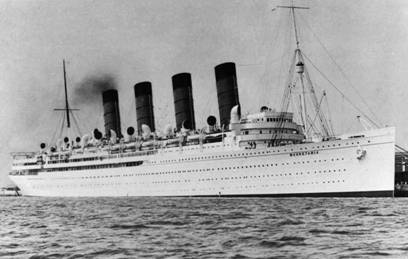
Figure 9. S.S. Mauretania.
(Photograph courtesy of Wikipedia.com)
There are 27 individuals listed in the Autocheques group, including three
other engineers. Autocheques was a
company that provided discount travel accommodation for members of many of
Britain’s leading car clubs. Given
the date of the voyage it is quite possible that the group was heading for the
1939 World’s Fair in Flushing Meadows New York.
The fair was held from the 30th of April
1939 to the 27th of October 1940.[30]
EPILOGUE
Over
many years I have researched medals of Royal Engineers who have served in the
Establishment for Engineer Services, Royal Engineers Services, Military Engineer
Services and in the Directorate of Works during the Great War.
Most of these men have been Warrant Officers or senior Non-Commissioned
Officers. The work I did on Major
Fred Harrison is the first work dealing with an officer, Inspector of Works, who
spent his entire time in the Army working in the Works Directorate.
I have had a copy of The Work of the Royal Engineers in the European War, 1914-1919; Work
Under the Director of Works (France) in my personal library for many years
and I have referred to it on numerous occasions to understand more fully the
work being done by the Warrant Officer or NCO that I was researching at the
time. Fred Harrison’s story
required much more than just a peek at some of the pages in the book.
It required an in-depth study of the functioning of the Directorate, its
composition, organization, personnel and areas of work.
I was amazed at what I found.
The Works Directorate consisted of an enormous logistical tail that
supported the British Army in the field in France and Flanders.
One realizes this when one examines the technical facilities and
responsibilities for which the Directorate was responsible.
Some things come as complete surprises, things like Fat-Extracting Plants
and Pig and Goat Farms, for example. Who
would have thought that these facilities came under the purview of the Royal
Engineers? And then there are the
number of Works bases and sub-bases established in France and Flanders to
support the Field Armies, the Corps and Divisions. It was truly a remarkable
organization consisting of many units and many people as seen in Annex A below.
The work on Major Harrison’s military service was truly a splendid
learning experience for me.
ANNEX A
Units Operating Under the Control of the Director of Works in France[31]
Between 1914 and 1918 the Works Directorate in France eventually came to
control the following units, or elements thereof:(*)
No. 7 Army Troops Company, Royal Monmouthshire Royal Engineers
No. 8 Army Troops Company, Royal Monmouthshire Royal Engineers
1/1st Dundee Army Troops Company, R.E
1/2nd Glamorgan Army Troops Company, R.E.
1/1st Sussex Army Troops Company, R.E.
1/3rd Cornwall Army Troops Company, R.E.
1/1st Devon Army Troops Company, R.E.
158th Army Troops Company, R.E.
No. 1 Siege Company, Royal Anglesey Royal Engineers
No. 4 Siege Company, Royal Anglesey Royal Engineers
No. 4 Siege Company, Royal Monmouthshire Royal Engineers
No. 6 Siege Company, Royal Monmouthshire Royal Engineers
781 Area Employment (Artisan) Company
936 Area Employment (Artisan) Company
938 Area Employment (Artisan) Company
939 Area Employment (Artisan) Company
940 Area Employment (Artisan) Company
941 Area Employment (Artisan) Company
942 Area Employment (Artisan) Company
944 Area Employment (Artisan) Company
945 Area Employment (Artisan) Company
NOTE: Area Employment (Artisan) Companies were raised entirely of “P.B.” or Permanent Base tradesmen who were unfit for general service but could do the same work as those in a regular Artisan Works Company if restricted to a particular base or area.
572 Devon Works Company, R.E.
No. 8 Reinforcement Party, R.E.
13th Reinforcement Party, R.E.
578 (Sussex) Works Company, R.E.
29th Works Company, R.E. (later 29th Advanced Park Company and then 29th General Headquarters Troops Company)
1st Base Park Company, R.E.
24th Base Park Company, R.E.
32nd Base Park Company, R.E.
51st Artisan Works Company, R.E.
52nd Artisan Works Company, R.E.
58th Artisan Works Company, R.E.
60th Artisan Works Company, R.E.
1501 Artisan Works Company, R.E. [later 922 Area Employment (Artisan) Company, R.E. and later 243 Artisan Works Company]
1502 Artisan Works Company, R.E.
1503 Artisan Works Company, R.E.
1504 Artisan Works Company, R.E.
1505 Artisan Works Company, R.E.
1506 Artisan Works Company, R.E.
240 Artisan Works Company, R.E. (later 919 Area Employment (Artisan) Company, R.E.)
241 Artisan Works Company, R.E. (later 920 Area Employment (Artisan) Company, R.E.)
242 Artisan Works Company, R.E. (later 921 Area Employment (Artisan) Company, R.E.)
923 Area Employment (Artisan) Company, R.E. (later 244 Army Works Company)
351 Electrical and Mechanical Company, R.E.
354 Electrical and Mechanical Company, R.E.
355 Electrical and Mechanical Company, R.E.
356 Electrical and Mechanical Company, R.E.
(*) In many cases only
headquarters, half companies or detachments of the units shown were under the
control of the Works Directorate. Royal
Engineers and Infantry Labour Battalions were sometimes employed by the Works
Directorate but were never a part of it.
At the beginning of 1917 the
newly formed Directorate of Labour took over control, administration and
allotment of all labour except Royal Engineers technical units, which included
Artisan Works Companies. The
Directorate of Labour principally employed:[32]
ANNEX B.
Figure
10. Passenger List of S.S.
Mauretania, 17 June 1939.
(Image courtesy of Ancestry.com)
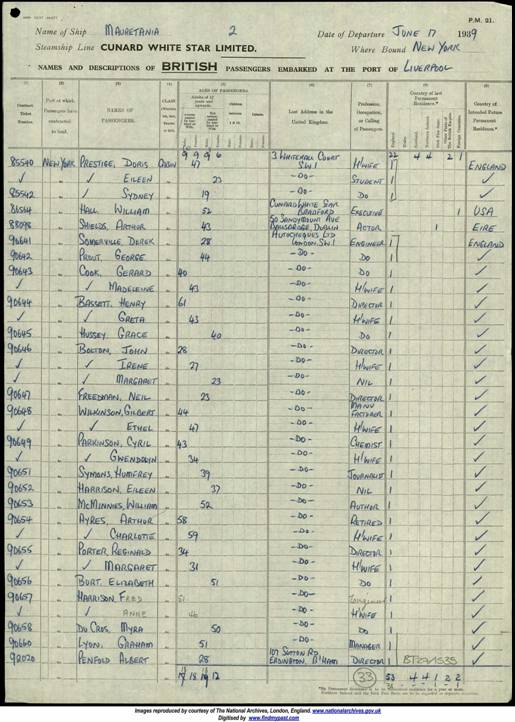
ANNEX C.
Details of Work at the Base at Le Havre.
If Fred Harrison spent the majority of his time in France working at the base at Havre, then he would have been involved in the following projects, at least to some extent. These projects span the time from November of 1914 when he was an Honorary Lieutenant to February of 1920 when he was a Temporary Lieutenant Colonel.
Havre Base was the principal base of the British Expeditionary Force for supplies and ordnance. It was located on the coast of France and consisted of a roughly triangular area with a base approximately 30 miles long and a height of about 30 miles. It included the city of Havre on the western point of the triangle, the town of St. Valery at the northern point and the town of Caudebec on the eastern point. The base of the area was bounded on the south by the River Seine and Havre harbor.
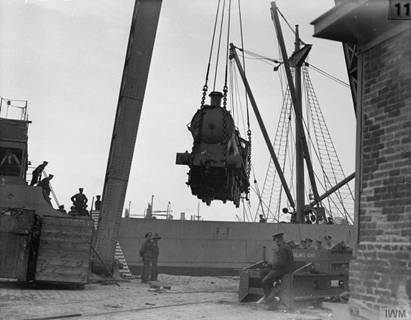
Figure 11. Unloading a
Locomotive at the Havre Base Depot, 23 May 1917
(Photograph courtesy of the Imperial War Museum)
Initially the base consisted of large dock hangars, a remount depot for 2,500 horses and a veterinary hospital for 1,000 horses. A field bakery with Aldershot ovens, was established near the docks. A hospital and post office[33] came next along with improvement to the water supply and a military prison. The housing scheme for the winter of 1914/1915 called for winter accommodation for 9,000 men and 3,600 horses.
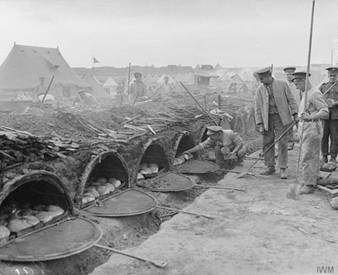
Figure 12. Aldershot Ovens
in a Field Bakery.
(Photograph courtesy of the Imperial War Museum.
In September of 1916 two floating pneumatic elevators and an extensive system of conveyor and pilers (devices for piling loose materials) were constructed. This equipment was required by to handle the bulk unloading of oats for horses. Other work consisted of the completion of winter accommodation, construction of ammunition depots, stores depots, jetties and improvement of port facilities, the construction of new camps and the extension of forestry, quarrying and engineer store operations.
In 1917 the 51st Artisan Works Company, R.E. was posted to the base at Havre. Work during the bitter winter of 1916/1917 continued with the construction of facilities that had been already started along with a winter hutting program, hospital extensions and camp improvements. It was during this period that Captain Harrison appears to have worked with the 51st Artisan Works Company.
By the summer of 1918 Harrison was a Temporary Lieutenant Colonel with much more responsibility than that of an Inspector of Works. At Havre he had to oversee the construction of an Officers’ Training School that included sleeping and messing accommodation for officers under training including the provision of lecture rooms and the separate accommodation for a large instructional staff. Also included in his projects was a large wagon repair shop together with a covered wagon park of light shedding. He also had to undertake the construction of an ordnance demobilization depot and vehicle reception park covering about 10 acres. In October a further large extension of the depot was ordered.
From August of 1918 until March of 1919 as a Deputy Assistant Director and then an Assistant Director of Works Harrison continued his duties in the Works Directorate at Havre. Work continues on the officer’s training school and a new saddler’s shop at Havre. Following the Armistice the work involved the construction of a 3,500-man reception camp, three dispatching camps (for a total of 7,500 men) adapted from existing camps and fully hutted. One delousing camp was required to accommodate 3,500 men per day as well as one hutted “concentration camp” for 2,000 men for the use of local troops being demobilized. In addition, the ordnance depot at Havre was required to be cleared of munitions so that the port facility could be turned back to the French.
By March of 1919 Harrison was employed with duties dealing with the disposal of surplus stores. This appears to have been a staff officer position within the Directorate of Works. Munitions appear to have been priorities items for disposal. The exact nature of his work was not uncovered during this research, but one can assume that anything the value of which exceeded the cost of shipping it back to England, was demobilized. Any stores that did not fall into this category may have been destroyed or left to the population of France and Belgium.
REFERENCES
Army Lists
Books
1.
INSTITUTION OF ROYAL ENGINEERS. The Works of the Royal Engineers in the European War, 1914-1919.
Work Under the Director of Works (France).
W. & J. Mackay & Co., Limited, Chatham, 1924.
2. WILLIAMSON, H. The
Great War Medal Collectors Companion, Volume III.
Anne Williamson, Harwich, Essex, 2014.
Census
1911 Census
of England and Wales, Wakefield, West Yorkshire.
Internet Web Sites
London Gazette
Medal Rolls and Medal Index Card
Passenger List
S.S. Mauretania,
departing Liverpool on 17 June 1939, bound for New York.
Periodicals
ENDNOTES
[1] Since no birth certificate has been located for Major Fred Harrison, his birth year as 1888 could possibly be in error by a year or two. Census documents were notorious for inaccuracies and the hospital record showing his age in 1917 also could have been in error.
[2] Later, Major General Sir Andrew Mitchell Stuart, KCMG, CB. Deceased, 28 November 1936.
[3] Work Under the Director of Works, p. 1.
[4] Later re-designated the 29th Advanced Park Company.
[5] Work Under the Director of Works, p. 1.
[6] By the end of the war there would be 55 Inspectors of Works in the Works Directorate.
[7] According to the February 1915 Army List, men of the Staff for Royal Engineer had a uniform that was described as blue, with bright blue facings and scarlet edgings. The author has never seen a photograph of this uniform.
[8] It is this assumption that led the author to believe that the young man, the “Engineer,” in the 1911 census might have been Lieutenant Fred Harrison.
[9] Commonwealth War Graves Commission. Roberts was the son of the late Samuel and Caroline Roberts of Plymouth and the husband of Florence M. Roberts of 10, Beaumont Road, Plymouth.
[10] Work Under the Director of Works, p. 10.
[11] According to the Institution of Electrical Engineers Journal Wilmot was an electrical engineer.
[12] R.E.S. stands for Royal Engineers Services, a postnominal used to distinguish war-commissioned officers of the Works Directorate from Regular Army Royal Engineers (R.E.).
[13] Work Under the Director of Works, p. 173.
[14] Ibid.
[15] Ibid.
[16] London Gazette of 11 March 1916.
[17] Forces War Records data.
[18] This age in 1917 coincides with a birth year of 1888 as previously noted.
[19] Ibid.
[20] London Gazette, 9 October 1918.
[21] Work Under the Director of Works, p. 57.
[22] Ibid.
[23] London Gazette, 15 February 1919.
[24] London Gazette, 14 July 1919.
[25] R.E. Medal Roll.
[26] This bar was authorized by King George V in 1919 to all who had been under fire during the period from 5 August 1914 to midnight on 22/23 August 1914.
[27] R.E. Medal Roll.
[28] These medals are in the author’s collection.
[29] One of the stranger ranks of NCOs in the Establishment for Engineer Services.
[30] If Harrison was heading for the World’s Fair at Flushing Meadows in New York it makes his story even more interesting for the author. My mother attended that World’s Fair pregnant with me. I also lived within walking distance of those fair grounds from 1954 to 1960.
[31] Work Under the Director of Works, Appendix to Section XX (opposite page 186)
[32] Work Under the Director of Works, p. 185.
[33] Manned by personnel of the Royal Engineers Postal Service.